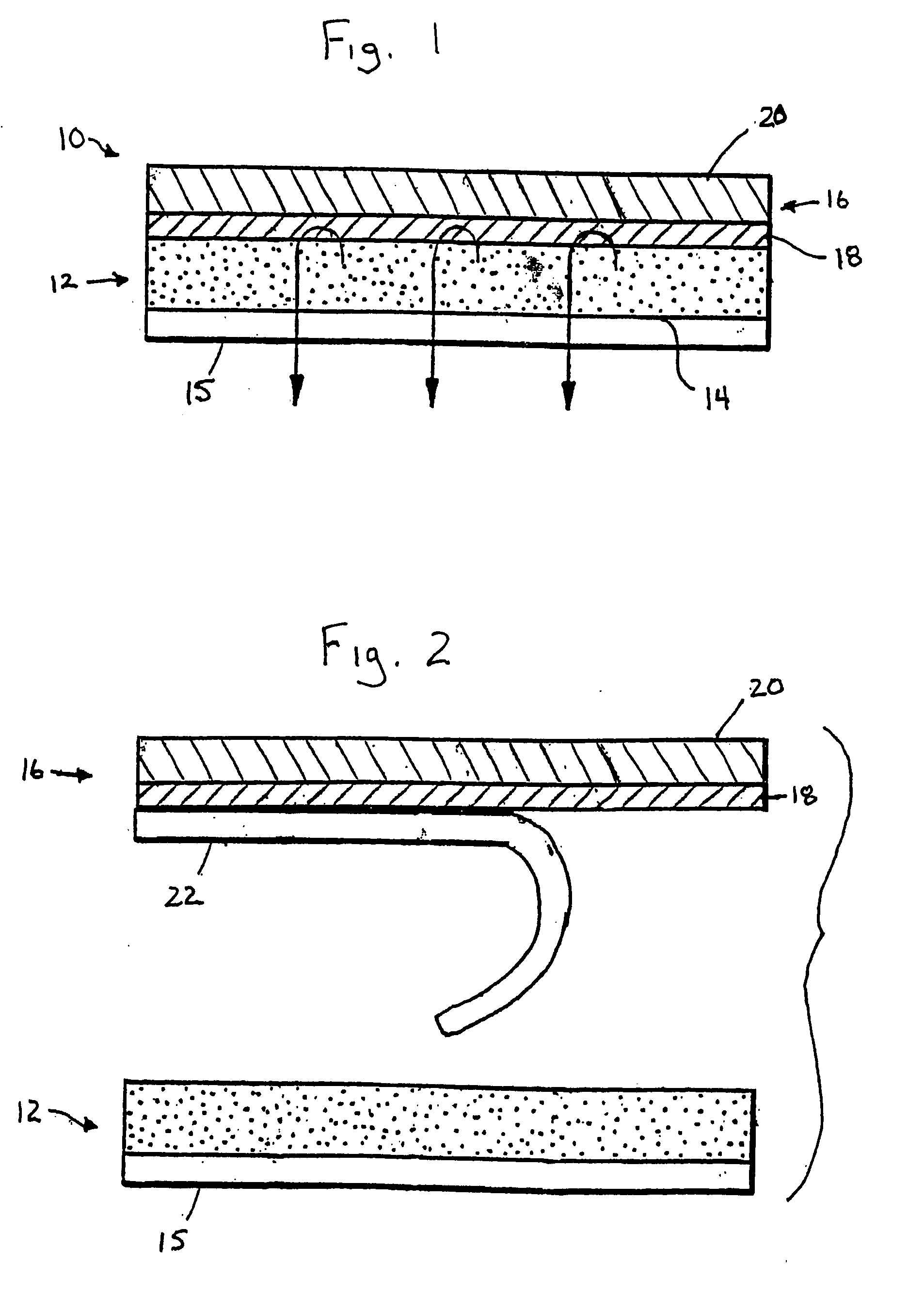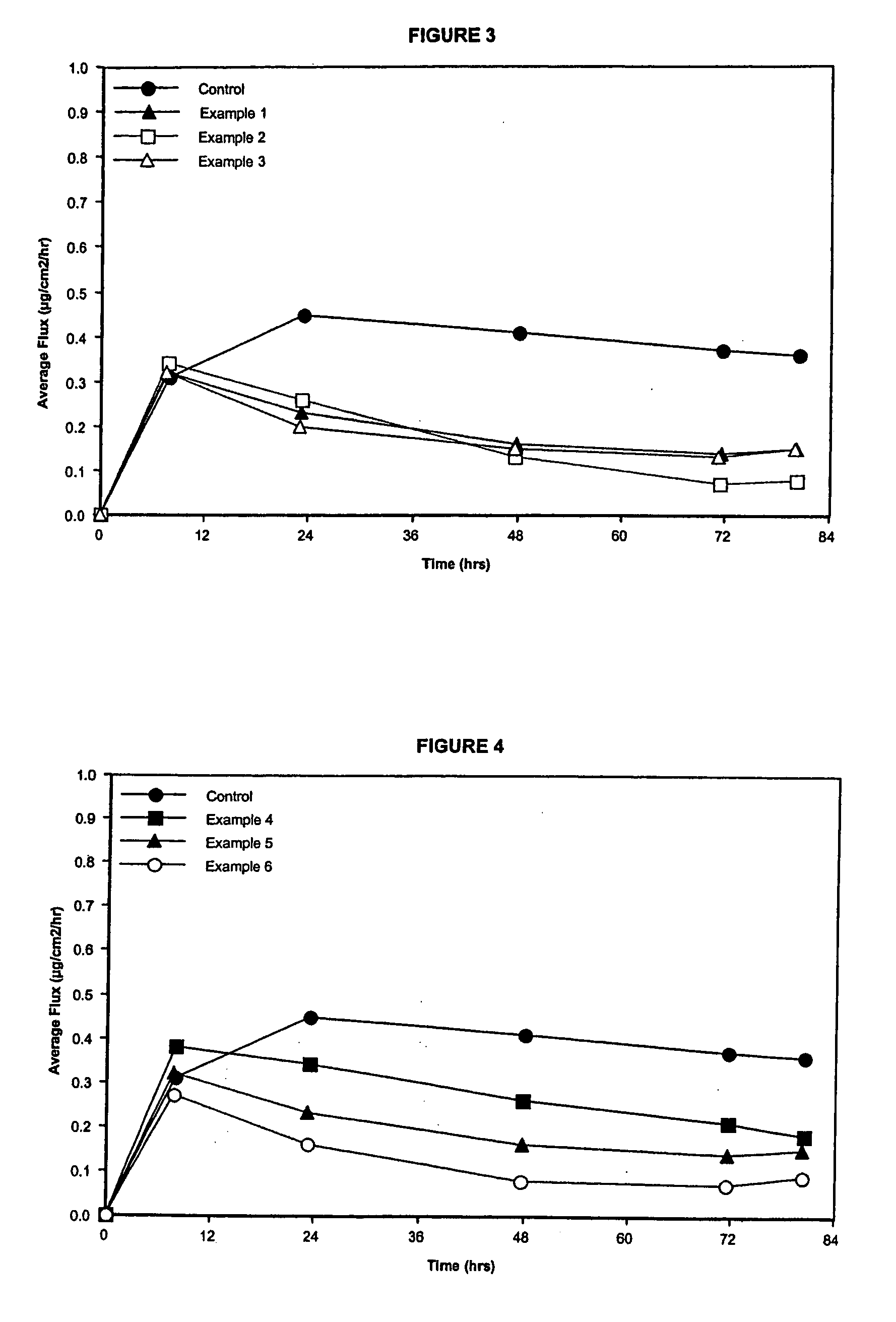Compositions and methods for delivering estradiol in transdermal drug delivery systems
a technology of transdermal drug delivery and estradiol, which is applied in the direction of pharmaceutical delivery mechanism, bandage, dressing, etc., can solve the problems of affecting or being adversely affected by, such carrier or matrix, and loss of drug in the manufacturing process again can be a significant problem, so as to prevent or minimize drug loss and/or other volatile components, and optimize drug loading.
- Summary
- Abstract
- Description
- Claims
- Application Information
AI Technical Summary
Benefits of technology
Problems solved by technology
Method used
Image
Examples
examples
[0116] In the Examples as shown with respect to FIGS. 3-4, the effect of variations in the non-drug loaded coating are determined, indicating the effective control of permeation rate, onset and profile thereby. Referring to the most preferred embodiment depicted in FIG. 1, while the Examples are directed to formulations using estradiol and an acrylic-based adhesive coating, it should be understood that similar drug modulation can be achieved with other active agents, and through the use of other polymers and system configurations as discussed.
[0117] All drug-loaded carrier compositions containing estradiol were prepared and coated onto a fluropolymer release liner and dried for 5 minutes at RT and 5 minutes in a 92° C. oven to produce a pressure-sensitive adhesive carrier composition by dry weight of 20% acrylate pressure-sensitive adhesive (GMS 788), 56% silicone pressure-sensitive adhesive (BIO-PSA-4502), 8% soluble povidone, 6% oleyl alcohol, 8% dipropylene glycol and 2% estradi...
examples 1-3
[0120] In Examples 1-3, the three acrylic acrylic coated backings utilized different moieties of acrylic polymer in their composition: Example 1 contains an acid functional moiety, Example 2 contains a non-functional / non-reactive moiety, and Example 3 contains a hydroxyl (—OH) functional moiety. The acrylic coating on the backing had a coat weight of 5.0 mg / cm2 and was coated onto a polyester film. The drug-in-adhesive matrix had a coat weight of 5.0 mg / cm2.
[0121]FIG. 3 illustrates the results for the three moieties of the acrylic-based polymer backings utilized. Acid functional and hydroxyl functional acrylic polymer backings had a similar effect on the delivery profile of estradiol. The non-functional / non-reactive moiety in the acrylic backing exhibited a decrease in the delivery profile after 48 hours of delivery compared to the acid functional and hydroxyl functional acrylic backings.
example 4-6
[0122] In Examples 4-6, a single acid functional acrylic polymer backing varying the coat weight was utilized. Coat weights for the acrylic backing were 2.5 mg / cm2, 5.0 mg / cm2, and 10.0 mg / cm2 for Examples 4, 5, and 6, respectively. The results, set forth in FIG. 4, illustrate that the permeation rate decreases as the acid functional acrylic backing thickness increases although the drug delivery profile appears to remain the same, at or near zero-order, for all three coat weights. The drug-in-adhesive matrix had a coat weight of 5.0 mg / cm2.
[0123] The examples show that by tailoring the acrylic backing polymer through changes in moiety and thickness one can attain a desired permeation rate and delivery profile for estradiol. As the functional moiety and thickness change, the permeation rate and delivery profile can be changed to create a transdermal patch with a multitude of delivery profiles and rates for a selected therapeutic target.
PUM
| Property | Measurement | Unit |
|---|---|---|
| time | aaaaa | aaaaa |
| body weight | aaaaa | aaaaa |
| body weight | aaaaa | aaaaa |
Abstract
Description
Claims
Application Information
 Login to View More
Login to View More - R&D
- Intellectual Property
- Life Sciences
- Materials
- Tech Scout
- Unparalleled Data Quality
- Higher Quality Content
- 60% Fewer Hallucinations
Browse by: Latest US Patents, China's latest patents, Technical Efficacy Thesaurus, Application Domain, Technology Topic, Popular Technical Reports.
© 2025 PatSnap. All rights reserved.Legal|Privacy policy|Modern Slavery Act Transparency Statement|Sitemap|About US| Contact US: help@patsnap.com


